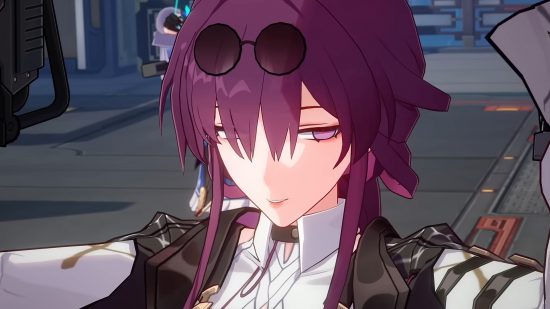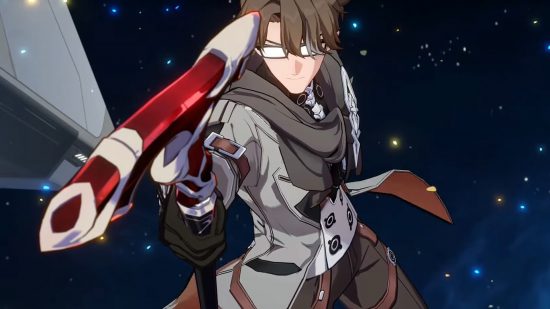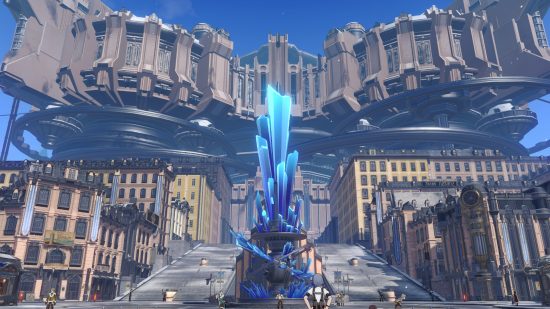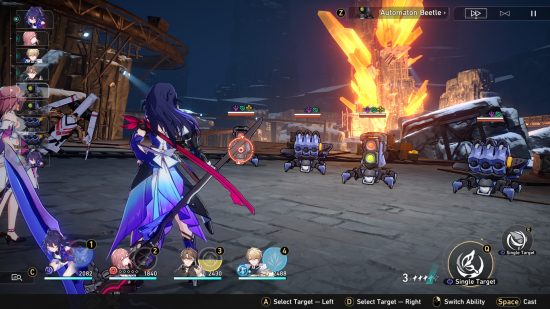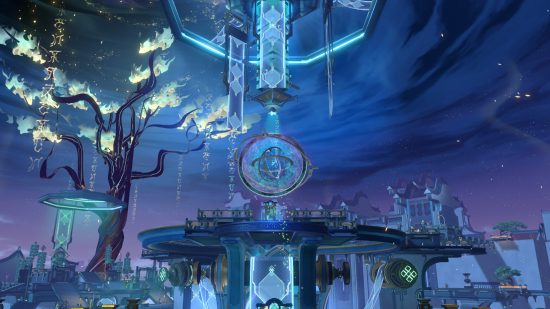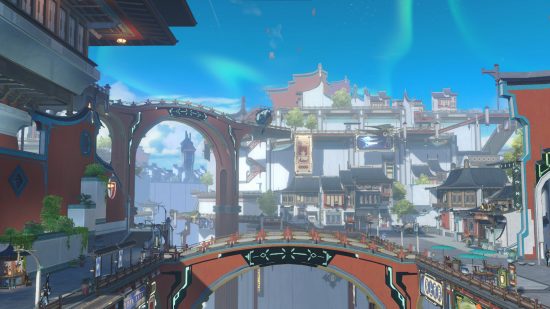Our Verdict
Honkai Star Rail is HoYoverse’s most confident showing yet. While its gameplay doesn’t really do anything new, it excels at the fundamentals. When matched with a memorable cast and enthralling story beats, it cements itself as one of the stronger releases of 2023 so far.
The initial reception to Honkai Star Rail, despite its hype, was certainly mixed. While longtime fans of developer HoYoverse’s games were mostly excited for the space fantasy RPG, others turned up their noses, deriding it as a turn-based Genshin Impact clone – particularly harsh words considering Genshin itself was quickly written off by many as a weeby, mobile-based Breath of the Wild knockoff when it initially launched. As those who dismissed Genshin back then were ceremoniously disproven, those who view Honkai Star Rail as simply ‘Genshin in space’ are in for a pleasant surprise.
Honkai Star Rail begins exactly as it means to go on: by throwing you, the Trailblazer, into absolute chaos. After being rudely awoken by Kafka and Silver Wolf – two operatives for an organization known as the Stellaron Hunters – you find yourself on a space station under fire from the antagonistic Antimatter Legion, with no memory of how you got there in the first place. Fortunately, Kafka imbues you with a Stellaron – a seed of ruin sown across the universe by the Aeon of Destruction, Nanook – which helps you and your trusty baseball bat bonk your way through the station.
Once the crisis has been averted, you find yourself in the company of the Trailblazers aboard the celestial locomotive known as the Astral Express. Their mission is to root out the Stellaron, and eliminate them before they inevitably bring ruin to whatever planet they land on. Of course, the amnesiac Trailblazer can’t do it alone, which is why you have other key Honkai Star Rail characters like the endlessly energetic March 7th – no, that’s not a nickname – and the softly-spoken Dan Heng by your side.
While your two companions are completely original to Honkai Star Rail, other Trailblazers like Himeko and Welt Yang are Honkai series staples. However, Honkai Star Rail is neither a sequel, nor is it a completely non-canonical spinoff, it is some third, secret thing – you’ll want to check out our Honkai Star Rail sequel guide on that one, but do note that you thankfully won’t have to swot up on anything lore-wise before jumping in.
Regardless, the characterisation of most of the series’ returning faces is distinct from their Honkai Impact counterparts, and the polish that’s gone into producing a vibrant cast across the board, is clear to see. HoYoverse has traditionally excelled at crafting big personalities – oftentimes based on popular tropes – and telling its stories through them. Honkai Star Rail is no exception and, as with Genshin Impact, the Honkai Star Rail voice actors have done a stellar job of bringing its characters to life.
Perhaps the biggest improvement on this front from Genshin is how much work has gone into developing Caelus and Stelle – the male and female iterations of the Trailblazer you can choose from at the start of the game. While, like in Genshin, the protagonist is mute for the most part, HoYo makes excellent use of text messages and other interactions between them and the characters they meet on their adventures to showcase their personalities.
Naturally, a larger-than-life cast requires a larger-than-life narrative melting pot to stew in – Honkai Star Rail doesn’t disappoint. Hearty helpings of melodrama, dashed with heartbreak, and topped with a healthy dollop of humor makes for a delectable dish. And these various flavors permeate everything from the main storyline, to sub quests, even down to the interactive trash cans which you’ll often find Stelle diving into while on Jarilo-VI – one of three currently-explorable locations.
The main story does have its foibles, though, particularly with regards to the pacing of parts of the Xianzhou Luofu – the region the main story quest currently cuts off in. There are certainly moments where urgency is lost due to switching between the planet ship’s two major story beats, though both are individually engrossing in their own ways. When it comes to Honkai Star Rail’s actual side story content, I have zero complaints.
Only in Honkai Star Rail can you go from experiencing a moving father-daughter side quest in one moment, to being cyberscammed by a catfish in the next. It’s genuinely funny thanks to how well it grounds its sci-fi setting in modern culture and, for the most part, understands how to balance its memes with the deep, meaningful moments which captivate its audience.
These big moments are further elevated by an excellent soundtrack, hallmarked by ‘Wildfire’ – a collaboration between HoYo and former Christian pop-punk musician Jonathan Steingard, which makes the game’s most important encounter so far go unfathomably hard. Music has always been another of HoYo’s strong suits, and it has outdone itself here.
Honkai Star Rail doesn’t just sound good, either. Although it lacks the vast open world of Genshin Impact’s Teyvat, HoYo does well to create bold visuals – be it Belabog’s monolithic Qilpoth Fort, which finds itself perched on ever-turning cogs, or the mystical Divination Commission that’s positioned among the artificial cloudscape of the Xianzhou Luofu.
But how does Star Rail’s actual gameplay hold up to its presentation? Well, as someone with two accounts – one Trailblaze Level 42, the other being totally free-to-play at 35 – after many, many, hours of gameplay, I can comfortably say Honkai Star Rail is a well-weighted turn-based RPG. At a surface level, its systems seem fairly pedestrian. Each linear section has a set number of chests to find, puzzles to solve, and interactions to uncover through conversing with various NPCs. Though, as with everything else, engaging dialogue elevates even the simplest tasks.
Combat, while solid, is also devoid of many of the more sophisticated mechanics found in the best RPG games like Persona 5 Royal. You have a basic attack – which in some cases can have a modified effect depending on the character – a skill, and an ultimate ability. There’s no way to block or skip your turn and, as a personal gripe, for some odd reason, despite needing to press a second time to confirm the action, you cannot cancel your ultimate ability should you misclick it.
Although it sounds uninspired at first, Honkai Star Rail executes the fundamentals well. Each character belongs to a certain path – this indicates their specialism, be it single-target damage, buffing allies, etc. – and wields a certain element. Enemies typically have multiple weaknesses, which when hit by the corresponding element consecutively causes their poise to break, applying a debuff based on the element, and preventing them from attacking until they recover.
While this rock, paper, scissors-style system isn’t as dynamic as the elemental reactions that lay at the heart of Genshin Impact’s combat, it’s an approachable starting point for those new to the genre. And it’s clear that HoYo is catering to its pre-existing audience, too.
I initially feared that this reaction-less reliance on certain elements and typings in isolation would necessitate pulling hard for premium characters – the HoYoverse gacha machine is in full force, after all – yet I’ve been able to comfortably clear much of the harder content on my free-to-play account, thanks to the quality of the four-star units which constitute some of the best Honkai Star Rail team comps.
On top of all of this, there are a couple of more modern turn-based RPG mechanics that I am pleased to see implemented – auto-battle and combat speed-up. As with most gacha titles, Honkai Star Rail requires a lot of grinding to ensure the denizens of the Honkai Star Rail tier list perform at their best, and it respects your time by offering the ability to quickly accrue materials and clear menial content. Just don’t expect it to hold your hand the whole way through Honkai Star Rail’s most challenging battles.
Indeed, Honkai Star Rail’s auto-battle AI works very well for the most part, but often trips up on particular mechanics such as enemy counters or barriers, necessitating the player retaking control and clearing them the old fashioned way. I wouldn’t necessarily see this as a problem, however, as having a perfect AI would remove any sense of achievement from beating the game’s biggest bosses. Get good, or suffer.
In addition, more time spent manually battling means more time appreciating Honkai Star Rail’s splendid battle animations, especially for ultimate abilities. My mouth dropped the first time Himeko poured a brew while calling down an orbital strike to completely eviscerate the poor trash mobs that sat quaking before me.
Then there are those which are clear references to other pieces of media. For example, Svarog menacingly fading in at Clara’s plea for help is a clear homage to the Fate series’ Illya and Berserker, while Sushang’s poultry-based ultimate is certainly not paltry, as she calls down Fu Hua’s chicken companion from Honkai Impact 3rd upon her foe.

Of course, dropping a giant chicken on an enemy is the peak of modern gaming, but where else can you dabble in chicken chucking outside of questing? Well, as Genshin Impact has the Spiral Abyss, Honkai Star Rail has the Forgotten Hall which leads into the Memory of Chaos. Here, players must defeat increasingly-difficult enemies at each stage, within a set number of turns in order to accrue the most stars. And stars, as we all know, mean prizes.
Fortunately, this isn’t the only endgame activity the game has to offer, and its counterpart is definitely what I’ve sunk the lion’s share of my time into so far. Tucked away in the Herta Space Station’s Master Control Zone you’ll find Honkai Star Rail’s roguelike mode, the Simulated Universe. This highly replayable, not-so-hidden gem ties elements from some of the best roguelike games – most notably Hades and Slay the Spire – together into what is easily my favorite part of the Honkai Star Rail experience.
Although the Simulated Universe, like most of Honkai Star Rail’s gameplay, may not offer the same level of depth as its genremates, it epitomizes what HoYo does best – drawing inspiration from some of the best systems in the genre, weebing them up, and making them approachable to players. It is easily the most challenging content I’ve played across both Honkai Star Rail and Genshin Impact outside of their respective Abysses, and I’m excited to see how it expands in the future.
The addition of the Simulated Universe is only the tip of the iceberg when it comes to improvements – be they quality of life or otherwise – the Honkai Star Rail team has made coming from Genshin Impact. There’s a larger stamina pool, which takes less time to completely refill, allowing players to farm more materials each day. You can also now craft specific pieces of gear, albeit with random rolls, from shards generated by dismantling trash Relics. This is great because farming for Relics has so far been about as joyous as farming for Artifacts in Genshin Impact – not very.
The devs have even added a button to reassign characters to a material gathering assignment upon their return – something which takes an unnecessary number of extra clicks to achieve in Teyvat. Indeed, it feels like the dossier of Genshin player requests was accidentally dropped on the Honkai Star Rail team’s desk during development and it ran with it. I’m certainly not complaining.
Honkai Star Rail’s gacha is slightly more benevolent than Genshin’s, too. While it’s a very solid turn-based RPG, we must remember that the game’s primary purpose is to generate lots of revenue for HoYo by being monstrously addictive and monetising progression. The studio has traditionally sprinkled a few free four-star characters into the mix to help get players going, with Genshin players even getting a shot pulling a five-star unit on its beginner banner. However, the odds for this are low, and many expected Honkai Star Rail to follow suit.
Fortunately, the reality is much more forgiving. Though Honkai Star Rail’s Departure Warp caps out at 50 wishes (discounted to 40), it does guarantee that a five-star character will join you on your adventure early on. This may sound like a lot, but considering how quickly you can accumulate Stellar Jade – the game’s premium currency – and Star Rail Passes early on, even casual players should be able to reach the cap within the first few days of play.
Heartbreakingly, though, all good things must come to an end. While you can expect to bask in enough Stellar Jade to sail the Xianzhou Luofu on for the first few weeks of play, each mission cleared and each chest opened gradually leads towards a vast emptiness that can only be filled by new content releases, or the undrawing of your pursestrings. Or, like me, you could always go full gacha gremlin and start a second account to bask in the opulence all over again.
While buying up stacks of Stellar Jade remains as prohibitively expensive as Primogems, those dolphins out there – such as myself – can make a much more modest investment either into the Express Supply Pass, or the Nameless Honor battle pass.
Picking up the supply pass will net you 300 Oneiric Shards, and 90 Stellar Jade each day for 30 days, for $4.99. Relative to the cost of bulk buying shards, you’re looking at about 50 bucks’-worth of value.
The battle pass, meanwhile, will juice you up with materials regardless of if you chose to stay on its free track, or stump up the cash for the premium rewards. While its value will diminish as you reach the super late game due to the gradual accumulation of more materials than you know what to do with, we’re a long way from that point, and right now it is not a bad investment if you do have cash to spare, and are willing to dive down that rabbit hole.
When it comes to buying chances at new units, however, I’d advise the utmost caution. Any iteration of gacha system – be it Honkai Star Rail’s Warps, or the loot boxes prevalent in games like FIFA 23 and Apex Legends – is designed to keep players spending more and more over time with the promise of an easier time in return. It’s easy to spend due to the FOMO that comes with chasing characters, but I promise you that there is plenty of enjoyment and achievement to be found in using the units you’ll naturally accumulate. If you’re desperate for a particular unit, then sure, go for it (hi, Kafka), but be sure to gacha gamble responsibly.
Taking a step back from my soapbox, it’s clear that Honkai Star Rail is a delightful, neatly-presented turn-based RPG experience that will appeal to fans of both the genre, as well as HoYo’s other titles. While HoYo doesn’t reinvent the wheel with its systems, it has elevated what it already excels at in characterisation and storytelling, while injecting quality of life improvements at multiple points that will have Genshin Impact players clamoring for the same treatment.
